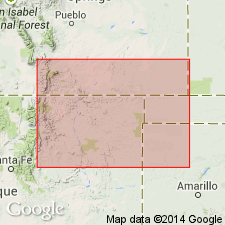
- Usage in publication:
-
- Cobert Canyon Sandstone Bed
- Modifications:
-
- Named
- Dominant lithology:
-
- Sandstone
- AAPG geologic province:
-
- Palo Duro basin
- Sierra Grande uplift
Summary:
Named as the upper bed of the Baldy Hill Formation for Cobert Canyon, north tributary of the Dry Cimarron River north of Baldy Hill, secs 23 and 24, T32N, R32E, Union Co, NM on the Sierra Grande uplift. Its type section (measured) is the type section of the Baldy Hill which is in the SE1/4 NE1/4 NE1/4 sec 36, T32N, R32E. The bed is a conglomeratic sandstone of limestone and lithic cobbles in a matrix of medium- to coarse-grained subarkose 3.0 m thick. The bed was formerly included with the overlying Travesser Formation. The bed is reassigned to the Baldy Hill because of a marked color change from grayish (Baldy Hill) to reddish brown (Travesser) at top of Cobert Canyon makes a good mapping contact for the dominantly reddish brown Travesser. The Cobert Canyon is a distinctive unit that contrasts with the underlying main body of Baldy Hill and the overlying Travesser. Crops out eastward along the Dry Cimarron into adjoining Cimarron Co, OK in the Palo Duro basin. Fossil metoposaurid labyrinthodonts and phytosaurs indicate Late Triassic (Carnian and Norian) age. Correlation chart. Is a low-sinuosity fluvial deposit.
Source: GNU records (USGS DDS-6; Denver GNULEX).
For more information, please contact Nancy Stamm, Geologic Names Committee Secretary.
Asterisk (*) indicates published by U.S. Geological Survey authors.
"No current usage" (†) implies that a name has been abandoned or has fallen into disuse. Former usage and, if known, replacement name given in parentheses ( ).
Slash (/) indicates name conflicts with nomenclatural guidelines (CSN, 1933; ACSN, 1961, 1970; NACSN, 1983, 2005, 2021). May be explained within brackets ([ ]).

